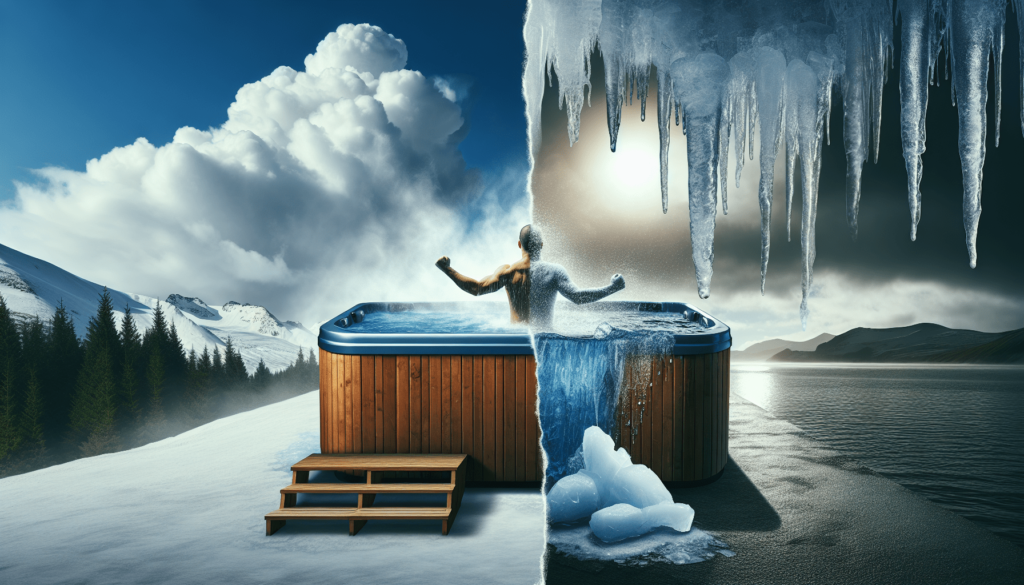Imagine yourself luxuriating in a warm, bubbling hot tub, feeling the stress of the day melt away. Now picture yourself suddenly taking a plunge into an icy cold pool. Sounds invigorating, right? But is it safe for your body? Today, we explore the curious question: is it okay to go from a hot tub to a cold plunge? We’ll uncover the potential benefits, risks, and expert advice to help you make an informed decision on this contrasting spa experience.

The Benefits of Hot Tub Usage
Relaxation and Stress Relief
One of the main benefits of using a hot tub is the relaxation it provides. The warm water and gentle vibrations help to soothe your body and mind, providing a much-needed break from the stresses of daily life. It’s a great way to unwind and let go of tension.
Muscle Pain and Tension Relief
Hot tubs are also known to provide relief from muscle pain and tension. The warm water helps to increase blood flow to your muscles, which can help to alleviate soreness and stiffness. Whether you’ve had a tough workout at the gym or are dealing with chronic muscle pain, a soak in a hot tub can work wonders.
Improved Sleep Quality
If you struggle with getting a good night’s sleep, a hot tub might be just what you need. The relaxation and warmth from the water can help to promote better sleep by reducing stress and releasing endorphins. Additionally, the drop in body temperature after you leave the hot tub can mimic the natural temperature drop that occurs during the sleep cycle, making it easier to fall asleep and stay asleep.
Increased Circulation
Another benefit of hot tub usage is improved circulation. As your body is exposed to the warm water, your blood vessels dilate, allowing for increased blood flow throughout your body. This can have a positive impact on your overall health, as improved circulation helps to deliver oxygen and nutrients to your muscles and organs more efficiently.
Reduced Symptoms of Arthritis
For individuals dealing with arthritis, a hot tub can provide much-needed relief. The warm water can help to reduce inflammation and stiffness in the joints, making it easier to move and alleviating pain. Regular hot tub sessions can improve joint flexibility and overall mobility for those with arthritis.
The Benefits of Cold Plunge
Muscle Recovery and Injury Prevention
Contrasting the hot tub experience, a cold plunge offers unique benefits for muscle recovery and injury prevention. The cold water helps to constrict blood vessels, reducing inflammation and preventing the build-up of lactic acid in the muscles. Regular cold plunges can aid in muscle recovery, allowing you to bounce back quicker from intense workouts or injuries.
Reduced Inflammation
Cold plunges are also effective in reducing inflammation throughout the body. The exposure to cold water causes blood vessels to constrict, which can help to reduce swelling and inflammation in joints, muscles, and tissues. This makes cold plunges particularly beneficial for those with conditions like arthritis or chronic inflammation.
Enhanced Mental Alertness
A cold plunge can be invigorating and help wake up both your body and mind. The shock of the cold water stimulates your nervous system and increases your heart rate. This jolt of energy can improve mental alertness, concentration, and overall mood. Many people find that starting their day with a cold plunge helps them feel more awake and focused.
Improved Immune Function
Regular cold plunges have been found to have a positive impact on immune function. The exposure to cold water can stimulate the production of white blood cells, which play a crucial role in fighting off infections and diseases. By regularly incorporating cold plunges into your routine, you can boost your immune system and be better equipped to ward off illnesses.
Skin and Hair Health
Cold water can have a rejuvenating effect on your skin and hair. The cold temperatures help to tighten pores and reduce oil production, which can lead to clearer and healthier skin. Additionally, cold water can help to add shine and volume to your hair, making it look more vibrant and healthy.
Contrasting Temperature Shock
Understanding the Effects
When transitioning from a hot tub to a cold plunge, your body experiences a drastic change in temperature. This temperature shock can have both positive and negative effects on your body. It’s important to understand these effects and how they can impact your overall health and well-being.
Risk Factors and Precautions
While many people can safely enjoy the contrast of hot tubs and cold plunges, there are certain risk factors and precautions to be aware of. People with certain medical conditions, such as cardiovascular issues or low blood pressure, may need to avoid extreme temperature changes. It’s always best to consult with a healthcare professional before incorporating hot tubs and cold plunges into your routine, especially if you have any pre-existing health concerns.
The Debate: Hot to Cold Plunge
Different Approaches and Preferences
When it comes to the debate between hot tub usage and cold plunges, it ultimately boils down to personal preference. Some individuals prefer the relaxation and warmth of a hot tub, while others enjoy the invigorating shock of a cold plunge. There is no right or wrong answer – it all depends on what works best for you and your body.
Contrasting Benefits and Effects
Hot tub usage and cold plunges offer different benefits and effects on the body. Hot tubs provide relaxation, muscle pain relief, improved sleep, increased circulation, and reduced symptoms of arthritis. On the other hand, cold plunges aid in muscle recovery, reduce inflammation, enhance mental alertness, improve immune function, and promote skin and hair health.
Impact on the Body and Health
Both hot tub usage and cold plunges have their own impact on the body and health. Hot tubs promote relaxation and can provide relief for muscle pain and tension. Conversely, cold plunges help with muscle recovery, reduce inflammation, enhance mental alertness, and improve immune function. Understanding how each temperature therapy affects your body is key in determining which option is best for you.

Hot Tub to Cold Plunge: Is it Safe?
Considerations for Individuals
When transitioning from a hot tub to a cold plunge, it’s important to consider individual factors. Factors such as existing medical conditions, body temperature sensitivity, and overall health should be taken into account. Everyone’s body is different, so what might work for one person may not work for another.
Importance of Gradual Temperature Changes
To ensure safety and minimize the risk of temperature shock, gradual temperature changes are crucial. Going from a hot tub directly into a cold plunge can put stress on your body, causing it to react negatively. Gradually decreasing the water temperature in the hot tub before entering the cold plunge allows your body to adjust more easily to the dramatic change.
Medical Conditions and Recommendations
Individuals with certain medical conditions, such as heart problems or Raynaud’s disease, should exercise caution when attempting hot tub to cold plunge transitions. These individuals may be more susceptible to adverse reactions from the extreme temperature changes. It’s important to consult with a healthcare professional to get personalized recommendations and ensure your safety.
Consultation with a Healthcare Professional
Before embarking on a hot tub and cold plunge routine, it’s always advisable to consult with a healthcare professional. They can assess your individual health status and provide guidance on the best temperature therapies for you. They can also help identify any potential risks or precautions specific to your health condition.
Tips for a Smooth Transition
Allow Sufficient Time to Adjust
When transitioning from a hot tub to a cold plunge, it’s essential to give your body enough time to adjust. Rushing the process can lead to temperature shock and adverse reactions. Take slow and deliberate steps in adjusting the water temperature and duration of your dips to allow your body to acclimate gradually.
Hydrate Properly
Staying properly hydrated is crucial when engaging in hot tub and cold plunge therapy. Both activities can cause sweating and increased fluid loss, so it’s important to replenish your body with water to maintain optimal hydration levels. Make sure to drink plenty of water before, during, and after your sessions.
Ensure Proper Warm-Up/Cool-Down
Before entering the hot tub or cold plunge, it’s important to properly warm up or cool down your body. Performing light stretches or exercises can help prepare your muscles for the hot or cold water and minimize any potential strain or injuries. Similarly, ending your session with a gentle cool-down period can help your body adjust to the temperature change.
Use Saunas or Steam Baths as Intermediaries
For those who find the transition from a hot tub to a cold plunge too intense, using saunas or steam baths as intermediaries can be a helpful alternative. These spaces allow you to gradually introduce your body to increasing temperatures before moving into the cold plunge. This can help reduce the shock to your system and make the transition more comfortable.
Listen to Your Body
Above all, it’s important to listen to your body and pay attention to how it responds to hot tubs and cold plunges. If you experience any discomfort, pain, or unusual symptoms, it’s essential to stop and seek medical advice. Everyone’s body is unique, so it’s crucial to honor your individual limits and adapt your routine accordingly.
Alternatives to Hot Tub to Cold Plunge
Contrasting Temperature Therapies
If the idea of transitioning between hot tubs and cold plunges isn’t appealing to you, there are alternative temperature therapies worth considering. Saunas and steam baths offer a consistent warm environment, providing relaxation and potential health benefits. Gradual temperature progression, such as taking showers with varying water temperatures, can also be a gentler alternative.
Alternating Warm and Cool Compresses
Another option is to incorporate alternating warm and cool compresses into your routine. This can be done by using heated compresses on specific areas of the body followed by cold compresses. The contrast of temperatures can help to stimulate blood flow, reduce inflammation, and provide some of the benefits associated with hot tubs and cold plunges.
Natural Cold Water Immersion
For the brave-hearted, natural cold water immersion can be an alternative to cold plunges. Swimming in natural bodies of cold water, such as lakes or oceans, can provide similar benefits to cold plunges without the need for specialized equipment. However, it’s crucial to exercise caution and only engage in natural cold water immersion if you are an experienced swimmer and are aware of any potential risks.
Conclusion
Ultimately, the decision to go from a hot tub to a cold plunge depends on individual factors such as personal preferences, health conditions, and comfort levels. Both hot tub usage and cold plunges offer unique benefits and can be incorporated into a well-rounded wellness routine. By understanding the potential risks, taking necessary precautions, and consulting with a healthcare professional, you can safely enjoy the benefits of temperature therapy and make informed decisions about what is best for your body and health.

